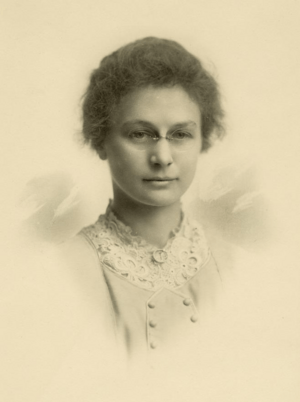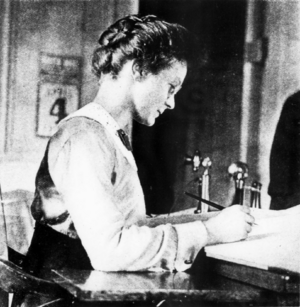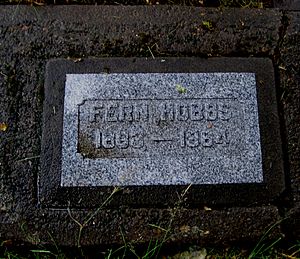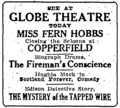Fern Hobbs facts for kids
Quick facts for kids
Fern Hobbs
|
|
|---|---|

Hobbs in 1913
|
|
| Born | May 8, 1883 |
| Died | April 10, 1964 (aged 80) |
| Resting place | Hillsboro Pioneer Cemetery |
| Occupation | secretary, attorney, commissioner |
Fern Hobbs (May 8, 1883 – April 10, 1964) was an American lawyer from Oregon. She was a special helper, called a Private Secretary, for Oregon Governor Oswald West. Fern Hobbs was known for being very determined and achieving a lot when she was young. She became the highest-paid woman working for the government in America by her mid-twenties.
Hobbs gained international attention when Governor West sent her to a small town called Copperfield. Her job was to bring back order using a special power called martial law. This event showed that the state government had power over even far-off communities. It also helped Governor West's efforts to make alcohol illegal, a time known as Prohibition.
Later in her life, Fern Hobbs worked for the American Red Cross in Europe. She also worked at The Oregon Journal newspaper. She passed away in Portland in 1964.
Contents
Fern Hobbs' Early Life and Career
Fern Hobbs was born on May 8, 1883, in Bloomington, Nebraska. Her parents were John Alden Hobbs and Cora Bush Hobbs. When she was six, her family moved to Salt Lake City, Utah. She lived there for 12 years and finished high school.
Her father then faced money problems. So, Fern moved to Oregon, settling in Hillsboro. There, she worked hard to support her younger brother and sister through school. She also studied how to be a secretary, which is called stenography.
She quickly became a private secretary for the president of a bank. This bank managed money for the Oregon Common School Fund. The bank later went out of business. Ben Olcott, who was the Oregon Secretary of State, was in charge of protecting the school fund's money. He noticed how loyal Fern Hobbs was to her boss.

After the bank closed, Hobbs worked as a governess in Portland. She continued to help her younger siblings. She also kept studying stenography and law. In 1913, Fern Hobbs earned her law degree from Willamette University College of Law. She was then allowed to practice law in Oregon.
Ben Olcott helped Oswald West become Governor of Oregon in 1910. Olcott suggested that West hire Fern Hobbs as his secretary. She was hired and impressed Governor West so much. Two years later, he made her his private secretary. At 27 years old, she earned $3,000 a year. This made her the highest-paid woman in public service in the United States.
Restoring Order in Copperfield, Oregon
On January 2, 1914, Governor West sent Fern Hobbs to Copperfield, Oregon. Her mission was to bring back law and order. She went with six militia men, including the prison warden B.K. Lawson. Copperfield was a town in Baker County, located on the Snake River. It had grown because of railroad and power plant construction. About 1,500 jobs came from these projects.
The town had become very disorderly. There were many places where people drank and gambled. The town had no police officers. Even the local government officials were running these places. Governor West had made laws to stop alcohol sales, but these were ignored in Copperfield. More than half the town's residents asked Governor West for help. They said that places owned by the mayor and city council members were selling alcohol to young people. They also stayed open too late.
Governor West told county officials to fix the problem. He wanted them to close the places selling alcohol and make the corrupt city leaders resign by December 25, 1913.
Armed? Well, yes; I am. I have a dressing bag, a portfolio and an umbrella. I don't believe I could do much damage with these. Do I look like a Carrie Nation to you?
When county officials did not solve the issue, West sent Fern Hobbs. He hoped that sending a woman would prevent violence. Hobbs was a small woman, about 5 feet 4 inches tall and weighing less than 100 pounds. She was ordered to restore order. If needed, she was to declare martial law. As Hobbs traveled, she and the Governor kept quiet about the militia men. They made it seem like Hobbs was going alone.
The people running the places selling alcohol heard that Hobbs was coming with law enforcement. They quickly decorated the town with ribbons and flowers. A town meeting was set for January 3. Hobbs asked the city officials to resign again, but they refused. Hobbs' escorts then arrested the city leaders. Lawson was ordered to declare martial law. This was the first time martial law was used in Oregon since the Civil War.
Soon, the town was disarmed and order was restored. Gambling equipment and weapons were taken away. The places selling alcohol were closed. Hobbs then left Lawson in charge and took the train out of town that same day. The residents did not openly fight Hobbs or the militia. However, most of them had weapons and were ready to resist peacefully. She stopped in Baker City to officially remove the town's officials in front of a judge. Then she returned to the state capitol in Salem.
The governor's actions were later challenged in court. Hobbs and West were among those sued. The court decided that the governor's actions were within his powers. The Oregon Supreme Court agreed.
These events made Fern Hobbs the most famous woman in Oregon at that time. She also made national and international news. A writer named Stewart Holbrook later wrote about how the story grew. He said that in England, people believed Miss Hobbs went to Copperfield with many soldiers and heavy weapons.
Fern Hobbs' Later Life and Legacy
After the Copperfield event, Fern Hobbs continued as Governor West's secretary until his term ended in 1915. She visited another town, Cove, in February 1914. She was there to check on complaints about a place selling alcohol. She did not order it closed, as the situation was legally unclear.
She then moved to Portland and practiced law. Groups supporting women's rights wanted Hobbs to run for governor. However, she never ran for public office. Within a few years, Fern Hobbs became a commissioner for the Oregon State Industrial Accident Commission. She worked on collecting taxes related to certain lands.
In 1917, when the United States entered World War I, she began working with the Red Cross. From 1917 to 1922, she worked in Europe. She was the chief of the casualty division in Paris, France. In this role, Hobbs was responsible for telling families when soldiers had died. She returned to Europe in the 1930s. She worked in the Rhine Valley when it was occupied by France.
After returning to Oregon, Hobbs worked as a secretary for The Oregon Journal newspaper. She retired in 1948 as the secretary to the paper's business manager. Fern Hobbs died on April 10, 1964, at the age of 80. She was buried at the Hillsboro Pioneer Cemetery in Hillsboro, Oregon.
Stewart Holbrook, an Oregon writer, interviewed her in the early 1950s. He noted that she still looked very well. He said she preferred to talk about her time with the Red Cross in World War I. She found that experience to be a "real adventure." He concluded that she saw the Copperfield event as a "deplorable incident."
Images for kids



